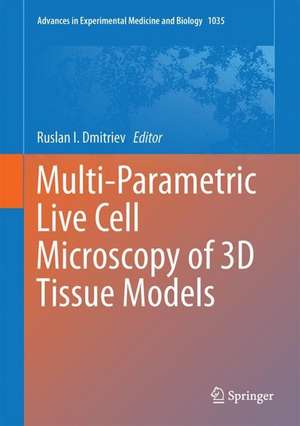Multi-Parametric Live Cell Microscopy of 3D Tissue Models: Advances in Experimental Medicine and Biology, cartea 1035
Editat de Ruslan I. Dmitrieven Limba Engleză Hardback – 10 noi 2017
| Toate formatele și edițiile | Preț | Express |
|---|---|---|
| Paperback (1) | 728.07 lei 39-44 zile | |
| Springer International Publishing – 23 iun 2018 | 728.07 lei 39-44 zile | |
| Hardback (1) | 894.46 lei 6-8 săpt. | |
| Springer International Publishing – 10 noi 2017 | 894.46 lei 6-8 săpt. |
Din seria Advances in Experimental Medicine and Biology
- 9%
 Preț: 719.56 lei
Preț: 719.56 lei - 5%
 Preț: 1113.83 lei
Preț: 1113.83 lei - 20%
 Preț: 691.93 lei
Preț: 691.93 lei - 5%
 Preț: 717.00 lei
Preț: 717.00 lei - 5%
 Preț: 717.00 lei
Preț: 717.00 lei - 5%
 Preț: 715.35 lei
Preț: 715.35 lei - 5%
 Preț: 716.28 lei
Preț: 716.28 lei - 5%
 Preț: 239.86 lei
Preț: 239.86 lei -
 Preț: 642.95 lei
Preț: 642.95 lei - 5%
 Preț: 820.42 lei
Preț: 820.42 lei - 5%
 Preț: 715.71 lei
Preț: 715.71 lei - 15%
 Preț: 640.24 lei
Preț: 640.24 lei - 15%
 Preț: 641.38 lei
Preț: 641.38 lei - 5%
 Preț: 1031.00 lei
Preț: 1031.00 lei - 5%
 Preț: 716.28 lei
Preț: 716.28 lei - 5%
 Preț: 717.20 lei
Preț: 717.20 lei - 20%
 Preț: 1161.71 lei
Preț: 1161.71 lei - 5%
 Preț: 1170.51 lei
Preț: 1170.51 lei - 18%
 Preț: 1119.87 lei
Preț: 1119.87 lei - 5%
 Preț: 1288.48 lei
Preț: 1288.48 lei - 5%
 Preț: 1164.67 lei
Preț: 1164.67 lei - 5%
 Preț: 1101.73 lei
Preț: 1101.73 lei - 18%
 Preț: 1123.67 lei
Preț: 1123.67 lei - 5%
 Preț: 1435.64 lei
Preț: 1435.64 lei - 20%
 Preț: 1044.10 lei
Preț: 1044.10 lei - 18%
 Preț: 946.39 lei
Preț: 946.39 lei - 5%
 Preț: 292.57 lei
Preț: 292.57 lei - 18%
 Preț: 957.62 lei
Preț: 957.62 lei - 18%
 Preț: 1235.76 lei
Preț: 1235.76 lei - 5%
 Preț: 1231.55 lei
Preț: 1231.55 lei - 5%
 Preț: 1292.30 lei
Preț: 1292.30 lei - 5%
 Preț: 1102.10 lei
Preț: 1102.10 lei - 18%
 Preț: 1132.81 lei
Preț: 1132.81 lei - 5%
 Preț: 1165.19 lei
Preț: 1165.19 lei - 5%
 Preț: 1418.48 lei
Preț: 1418.48 lei - 5%
 Preț: 1305.63 lei
Preț: 1305.63 lei - 18%
 Preț: 1417.72 lei
Preț: 1417.72 lei - 18%
 Preț: 1412.99 lei
Preț: 1412.99 lei - 24%
 Preț: 806.15 lei
Preț: 806.15 lei - 18%
 Preț: 1243.29 lei
Preț: 1243.29 lei - 5%
 Preț: 1429.44 lei
Preț: 1429.44 lei - 5%
 Preț: 1618.70 lei
Preț: 1618.70 lei - 5%
 Preț: 1305.12 lei
Preț: 1305.12 lei - 18%
 Preț: 1124.92 lei
Preț: 1124.92 lei - 5%
 Preț: 1097.54 lei
Preț: 1097.54 lei - 15%
 Preț: 649.87 lei
Preț: 649.87 lei - 5%
 Preț: 1097.54 lei
Preț: 1097.54 lei - 18%
 Preț: 945.79 lei
Preț: 945.79 lei
Preț: 894.46 lei
Preț vechi: 1090.81 lei
-18% Nou
Puncte Express: 1342
Preț estimativ în valută:
171.17€ • 178.93$ • 144.64£
171.17€ • 178.93$ • 144.64£
Carte tipărită la comandă
Livrare economică 06-20 martie
Preluare comenzi: 021 569.72.76
Specificații
ISBN-13: 9783319673578
ISBN-10: 3319673572
Pagini: 172
Ilustrații: XII, 172 p. 53 illus., 39 illus. in color.
Dimensiuni: 178 x 254 mm
Greutate: 0.54 kg
Ediția:1st ed. 2017
Editura: Springer International Publishing
Colecția Springer
Seria Advances in Experimental Medicine and Biology
Locul publicării:Cham, Switzerland
ISBN-10: 3319673572
Pagini: 172
Ilustrații: XII, 172 p. 53 illus., 39 illus. in color.
Dimensiuni: 178 x 254 mm
Greutate: 0.54 kg
Ediția:1st ed. 2017
Editura: Springer International Publishing
Colecția Springer
Seria Advances in Experimental Medicine and Biology
Locul publicării:Cham, Switzerland
Cuprins
Current state-of-the-art 3D tissue models and their compatibility with live cell imaging.- Simultaneous Phosphorescence and Fluorescence Lifetime Imaging by Multi-Dimensional TCSPC and Multi-Pulse Excitation.- Quantitative live cell FLIM imaging in three dimensions.- Three-dimensional tissue models and available probes for multi-parametric live cell microscopy: a brief overview.- Fabrication and handling of 3D scaffolds based on polymers and decellularized tissues.- Multi-parametric imaging of hypoxia and cell cycle in intestinal organoid culture.- Imaging of intracellular pH in tumor spheroids using genetically encoded sensor SypHer2.- Application of fluorescence lifetime imaging (FLIM) to measure intracellular environments in a single cell.- Quantitative imaging of Ca2+ by 3D-FLIM in live tissues.- Live cell imaging of viscosity in 3D tumour cell models.- Live imaging of cell invasion using a multicellular spheroid model and lightsheet microscopy.- Raman imaging microscopy for quantitative analysis of biological samples.
Notă biografică
Ruslan I. Dmitriev graduated from Lomonosov Moscow State Academy of Fine Chemical Technology (MSc) and Shemyakin-Ovchinnikov Institute of Bioorganic Chemistry (PhD, 2008), where he studied membrane ion-transporting proteins and protein interactions. He trained as postdoc at University College Cork, focusing on cell metabolism, hypoxia research and development and biological applications of cell-penetrating phosphorescent probes for molecular oxygen. Since 2014, he leads Metabolic Imaging group at University College Cork, where he designs novel biocompatible FLIM and PLIM biosensors for 3D tissue models for regenerative medicine and cancer biology.
Textul de pe ultima copertă
This book provides an essential overview of existing state-of-the-art quantitative imaging methodologies and protocols (intensity-based ratiometric and FLIM/ PLIM). A variety of applications are covered, including multi-parametric quantitative imaging in intestinal organoid culture, autofluorescence imaging in cancer and stem cell biology, Ca2+ imaging in neural ex vivo tissue models, as well as multi-parametric imaging of pH and viscosity in cancer biology. The current state-of-the-art of 3D tissue models and their compatibility with live cell imaging is also covered. This is an ideal book for specialists working in tissue engineering and designing novel biomaterial.
Caracteristici
Provides easy-to-follow protocols for specialists in cancer biology and tissue engineering Details current achievements in design and application of probes, dye, and nanoparticles as well as sensors for live cell imaging of 3D tissue models Consolidates cross-disciplinary knowledge of modern microscopy with tissue engineering approaches Includes supplementary material: sn.pub/extras
